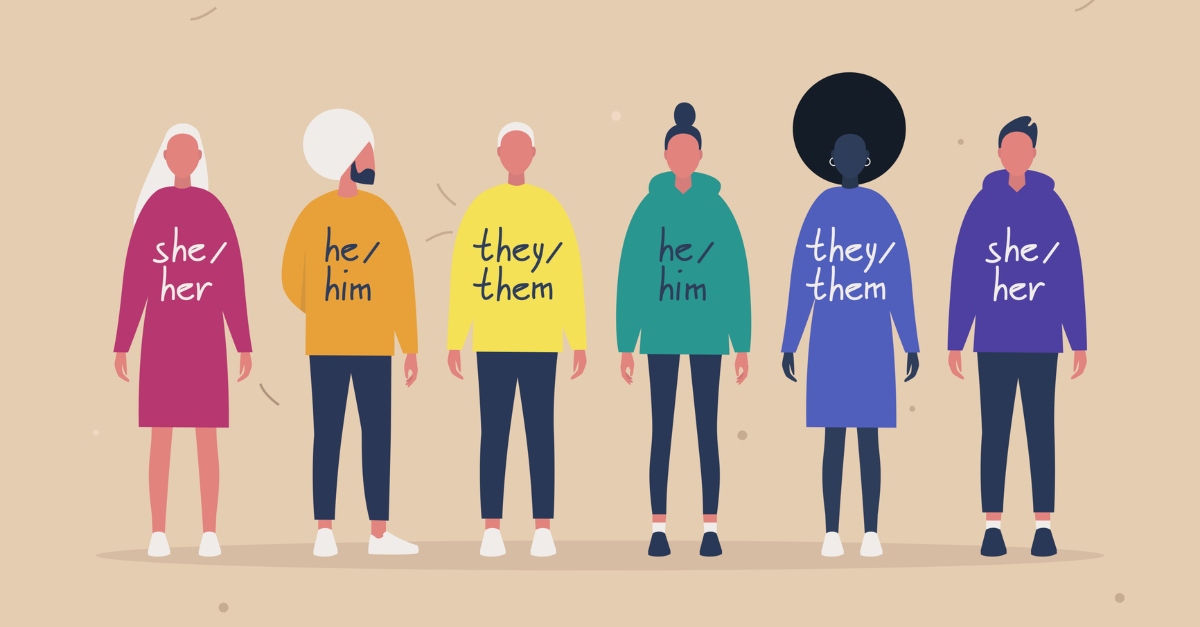
For a long time, people didn't think much about the pronouns they used when referring to certain individuals. But the more we learned about gender identity, and the more we listened to the community most impacted by misuse of gender pronouns, the more we realized that pronouns actually matter.
The main reason is actually pretty simple — using the pronoun someone prefers, whether that means she/her, he/him, or they/them, is a show of respect. But that's not to say that it doesn't take some practice — it does, and that's OK. If you aren't used to referring to someone by their desired pronouns when they don't match up with the idea you had of that person, or if someone you know recently transitioned, you're bound to make mistakes.
The important thing is to listen and to make sure your intentions are in the right place. Refusing to call someone by the pronouns they most associate themselves with, though, is another story altogether. It shows that you aren't willing to adapt to make someone else feel seen, or feel comfortable.
Having respect for individuals regardless of their gender identity is of huge importance. That's what using someone's preferred choice of pronouns is all about. For some people, this concept is still very new. That's what makes it so important to teach to our kids.
Before you talk about pronouns with kids, you need to fill them in on a few things. For starters, they need to know that not everyone identifies as male or female. Also, not everyone identifies as being the same gender as their anatomical sex. It seems tricky, but honestly, if kids are introduced at a young-enough age to the concept of gender identity — that how you feel is who you are — it becomes ingrained pretty quickly.
Another important part of the conversation is making sure that kids know it's OK to make mistakes and to ask questions. For many kids, that comes easier than it does for adults! Adults get caught up in always being right. But if kids are confused, they usually just ask. When it comes to learning about gender identity and the appropriate use of pronouns, that's huge!
Asking questions is also important when you aren't sure what someone's preferred pronouns are. We're getting more comfortable with the idea that it's OK to ask, "Hey, what are your preferred pronouns?" In fact, it's better to ask than to misgender someone. If we can teach kids that asking is better than assuming, we're definitely on the right track.
We may not all be experts on the subject. The most important piece of the puzzle is making sure that our kids are learning about the importance of pronouns, though. If your child's gender matches their anatomical sex, it might be tough to understand. You can help them understand by imagining how it would feel if they were misgendered.
For example, if your daughter ever got a short haircut and was called a boy, or your son had on pink and was called a girl, chances are they've experienced that discomfort in a very minor way. Kids who have transitioned have likely experienced being misgendered regularly. It's tough to put ourselves in that position, but no one likes not feeling recognized as who they really are.
Using someone's preferred pronouns does just that — it makes people feel seen. And that's what we all, including kids, should strive to do whenever possible. But there's another very important reason why you should open up conversations about gender pronouns with your kids — because they may need those conversations for personal reasons.
Being transgender is not as uncommon as we once thought it to be — people simply felt they had to hide their true identities so they wouldn't be discriminated against. But now we're seeing that many people, including some of our children, are trying to figure out their own gender identities! Many kids know their true gender at a very young age, too, so the earlier you can begin those important conversations, the better.
Even if your child is not confused about their gender identity, or they are potentially transitioning, it's still incredibly important to raise compassionate humans. That means understanding that all human beings deserve to be recognized for who they are — not who we think they are. That starts with calling them by their preferred pronouns.
While these kinds of conversations can seem tough at first, the truth about kids is that the more they are exposed to something, the more normal it becomes. Oftentimes, starting the talk is the trickiest part. But kids are typically pretty good at understanding compassion — which is at the very heart of understanding gender identity.




